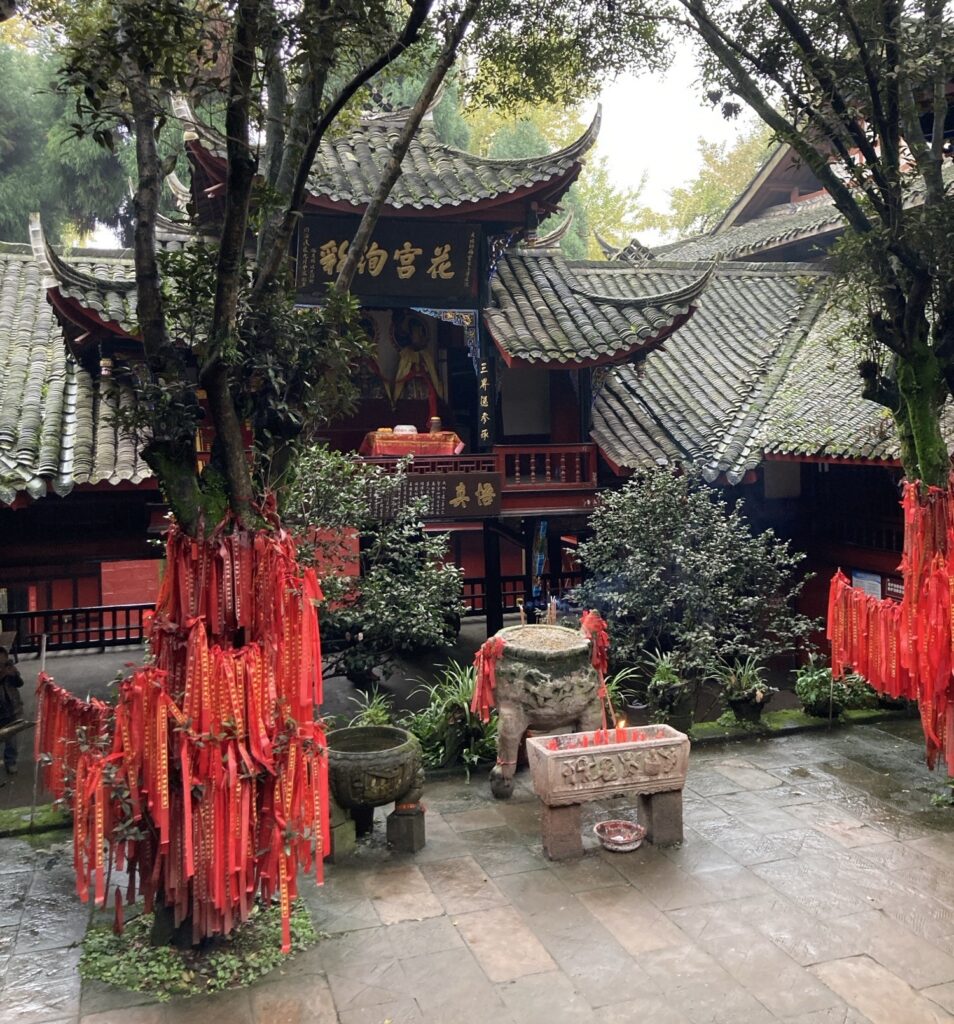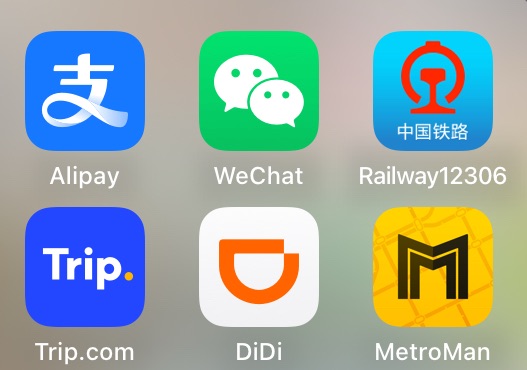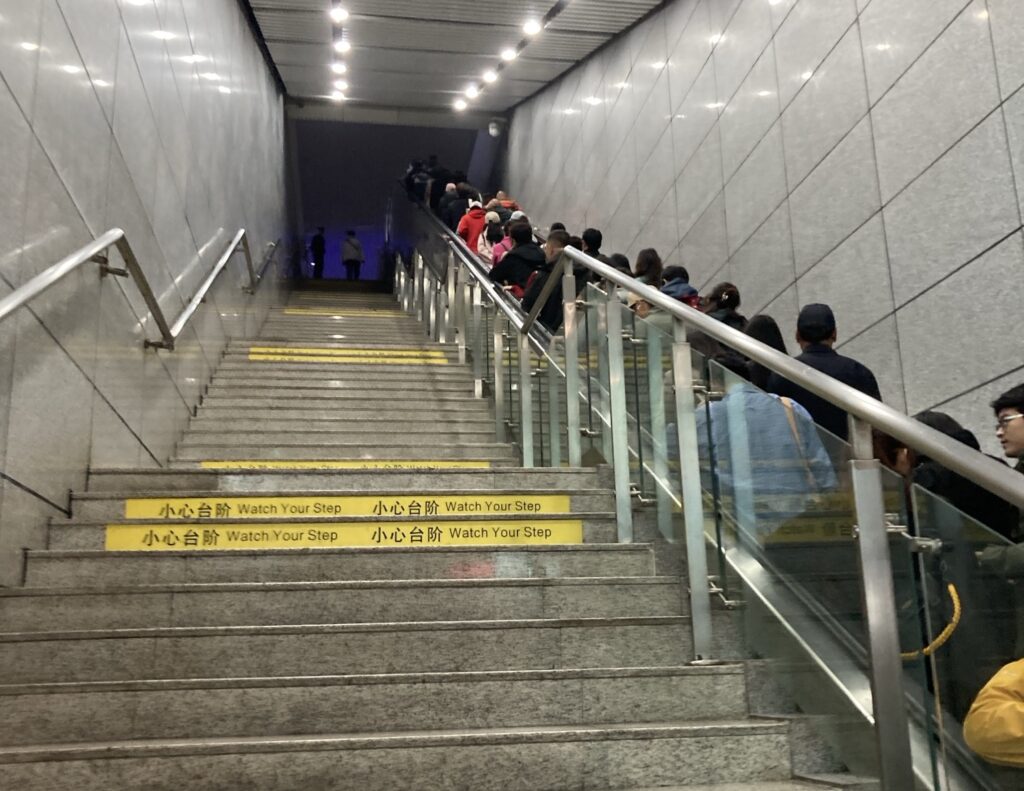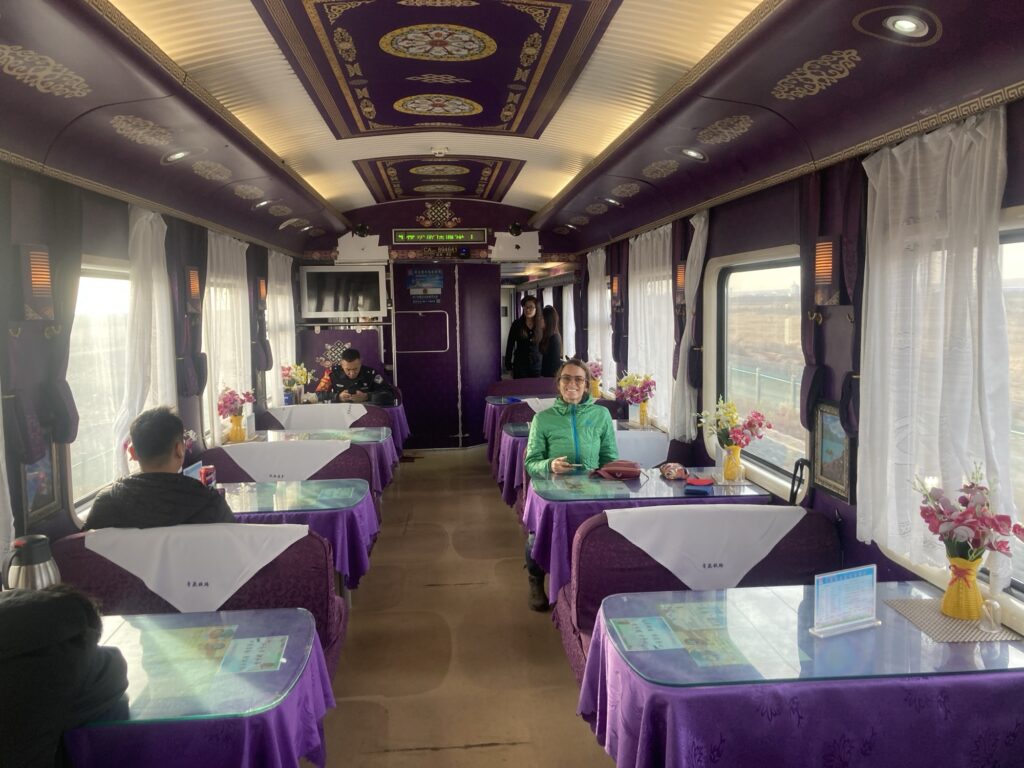How to book train tickets, navigate Chinese cities, pay for food and hotels, and have an amazing time travelling overland through China by train – from Laos, through Yunnan and Sichuan, to Tibet.

China enthralled us with its mix of sparkling modern cities and infrastructure, depth of history, natural beauty, friendly curious locals and delicious food. We chose to use the visa free period available to French passport holders (and many others), meaning we only had 15 days to get from the Laos border to the Nepal border. Travelling across Yunnan, Sichuan and Tibet, we made the most of China’s great rail network. This post focuses on how we purchased tickets and navigated China’s stations and train network, and the apps we used to pay and communicate in China.
Immigration and using the visa free period in China
Entering China from Laos on the Laos China Railway, the train stops at Mohan station for immigration formalities. Chinese immigration staff were friendly to us and helped us to fill out entry forms. We didn’t fill out our exit point as we didn’t want questions being asked about our intention to visit Tibet, this wasn’t a problem and no questions were asked, it was all very stress free. We didn’t need a visa thanks to the visa free period granted to passport holders of 38 countries, including many European countries, Australia, New Zealand and Japan. This visa free period has now been extended to 30 days. Given the difficulty of obtaining a Chinese visa (invitation letter, or detailed itinerary etc.), using the visa free period is a no brainier if available to you. We weren’t asked to show any documents proving onward travel, or our plans in China, and our understanding is that you can leave and re-enter China as many times as you like visa free, as long as each trip respects the 30 day limit.
Cash and payment Apps in China
Researching before travelling to China we came across many people ardently saying that cash was still accepted everywhere, and just as many saying that QR code based eWallet apps are now the only way to go. We hedged our bets, setting up accounts with Alipay and WeChat before heading China.
Setting up Alipay and WeChat
Both Alipay and WeChat required verification using a phone number, we did this with our Australian numbers. It worked fine for me but Margot couldn’t get passed the verification step on We Chat. She just asked the first friendly chinese person we met to verify her and that worked fine. I have heard that you may have difficulty with numbers from certain countries and an ISP address from certain countries, so it pays to test all this well in advance. Once you’ve created your Alipay account you can add your foreign cards to Alipay and they will be automatically debited when you make a payment via Alipay. You may be asked to verify your account by uploading a copy of your passport. As a foreigner you can only make payments to merchants, you can’t pay or receive money from individuals.
Note that Alipay charges a fee for payments over 200 yuan, so we suggest just breaking up payments to avoid this if possible.

We set up both Alipay and WeChat as a) not all merchants use both, for example in Tibet many shops only had a WeChat QR code, and b) WeChat has the added advantage of being a messenger service, very useful in communicating with Chinese businesses and anyone you meet. An added bonus is the inbuilt translation feature in WeChat messenger.
Using cash in China
A key caveat for QR code based ePayment apps is that they require internet to make payments, as you need to approve the payment in the App. If you’re out of reception or phone battery, you don’t want to get stuck, so having some cash on hand is always useful. We withdrew cash from China Post ATMs, for an unknown reason we didn’t question, there was no charge for using our Revolut card! There was scarcely any occasion where we couldn’t use electronic payment, but it was still good to have cash, especially as we’re planning to re-enter China from Pakistan and we’ve heard cash is needed for the journey to Kashgar.
Other useful apps
Almost no one we came across during our travels across Southwestern China spoke English. The exceptions were a few hostel staff, or Chinese who had lived and travelled abroad. Therefore, translate apps are key. As we had access to Google, we just used Google Translate. But many Chinese seemed to have much better apps, maybe you can find a better alternative to Google.
For getting around, and with Google Maps not having public transport information in China, we used Amap, the mapping app that most Chinese people seem to use, with public transport information. Apple Maps also works, (it’s a poor app, but with useful metro and bus info), and also MetroMan, a very easy to use app with public transport journey planning for major cities. Maps.me was also useful for navigating on foot, and the offline maps often come in handy.

Didi is the Chinese Uber, and very useful for getting around quickly and cheaply. You can pay via Alipay.
Phone and internet connection in China
Internet in China is protected by the Great Firewall. This means no Google suite, no WhatsApp, no Facebook, Instagram, YouTube, etc. There are ways to get around this.
If you roam using a foreign SIM card, you won’t face any of these restrictions. We chose to use the 19.99€/month roaming option with our French mobile operator, Free. Beware with Free you must wait 3 months before you can step back down to the 2€/month plan.
VPNs offer another way to get around the firewall. We used both a VPN and roaming, so had no issues. We also chose to never connect to a Wifi network in China, instead just using our phone data.
Travelling by train in China
A few key things to know about trains in China:
- Your passport is your ticket. You show your passport to enter the station, and to pass the boarding gate for your train, aaaand to exit the train. Make sure that your passport details are correct when booking your tickets! Some stations have boarding gates that accept passports, but in most cases we had to go through the manual gate, showing our passports to staff.
- Train ticket sales open two weeks before the date of travel. But on third party platforms you can book up to three months in advance and they will buy your tickets from the Chinese railway operator and confirm your booking as soon as the the two week window opens.
- Get to the station at least 30-45 minutes before the scheduled departure time. Major Chinese railway stations are as big as airports, so you’ll need this time to pass security and the passport (ticket) controls, find your boarding gate, and discover some fun food, before boarding.
- All intercity trains (that we experienced) have restaurant cars or travelling snack sellers.
- Power sockets are available at your seat on almost all trains.
Booking tickets for trains in China as a foreigner
Most tickets can be booked on third party platforms such as Trip.com. Such platforms charge a fee of around 6€ per booking, they are super easy to use and you can order tickets well in advance of the two week sale window for tickets purchased directly from the rail operator.
Booking tickets to Tibet
Many (including us) have had issues using third party platforms to buy train tickets to travel to Tibet. Our booking for a train from Lanzhou to Lhasa was continually rejected just after payment on Trip.com. This meant a) being very stressed about making it to Lhasa in time for our tour, and b) being out of pocket many hundreds of euros until the Trip.com refunds were processed. No reason was given by Trip.com for this issue, but we presume it’s due to the need for foreigners to have permits to board trains to Tibet.
This issue led us to investigate other options for buying tickets.
Buying tickets directly from China Railway as a foreigner
China Railway now has an English webpage for ticket sales and an App available in English (we used it on iPhone).
You will need to create an account and add the full details of passengers you wish to book tickets for, before being able to buy any tickets. After trial and error what worked for us was creating the account and adding all passenger details on the webpage, then switching to the app, finding the trains and booking tickets in the app.
Using the China Railway webpage
I started off on the webpage, on an iPhone and iPad, and while I was able to create an account, I was not able to find the tickets I was looking for because, a) the website is not smartphone compatible and therefore doesn’t display correctly, and b) city names need to appear correctly in Chinese characters, typing city names in English may not yield the right results.
If you receive the message ‘System is busy. Please try again later.’ this is an error message, it is due to an issue with your input to the website, and nothing to do with the system being busy or not. Try copying in city names in Chinese characters directly, and varying other inputs. You may have better luck using a computer rather than a phone or tablet. I certainly recommend just using the app.
Using the Railway12306 App
The China Railway app is MUCH more user friendly than the website. However, I still had trouble adding passenger details on the app, so I ended up painstakingly adding all passenger details to my account via the webpage. Note that you can only be logged into your China Railway account on one device at a time.
With all details added I was able to search for trains, add passengers (from the list of saved passengers on my account), book tickets, and pay with my foreign visa or master card. You can also pay directly with Alipay.
Once everything was set up with the app, it was a breeze to use and preferable to Trip.com as it’s free, and easy to cancel or edit tickets. For example, we arrived at Kunming Station only to realise that the train we had booked left from Kunming South Station, a 45 minute metro ride away. In 5 minutes I was able to cancel our tickets for the train leaving from Kunming South and book tickets for a train just about to leave from Kunming Station. The cancellation fees were minimal.
Finding and booking accommodation in China
Trip.com was the perfect resource for finding and booking hotels in China. You can easily filter options and search using the map. The hotels we stayed in were all very cheap, clean and easy to find. We chose hotels or hostels close to stations or sights and with great reviews, for a double room we paid between 6€ and 10€ per night, a bargain! Note that certain hotel rooms permit smoking, you can filter for non-smoking rooms only.
Trip.com provides confirmation of your reservation in English and Chinese.
Exploring Yunnan, Sichuan and Tibet
With (almost) all the logistical elements organised in advance, we were free to dive right in and enjoy our whirlwind tour of certain sights in Yunnan and Sichuan, before joining our tour in Lhasa.
Yunnan: Kunming, Lijiang and Tiger Leaping Gorge
Arriving from Laos, Kunming was our first stop. A delightful city with some beautiful parks and a calm, modern city centre. We stayed near Kunming Station which made getting around very easy.
The fast train got us to Lijiang in around 3 hours, and we definitely recommend visiting this UNESCO listed old town, with wonderfully preserved architecture. While the old town is very touristy, we only saw domestic tourists, and westerners are seen more as a curiosity than an economic opportunity, a nice change from Southeast Asia. We stayed at Mama Naxi Guesthouse, very comfortable and conveniently located. This is one of the few places used to western tourists and they were able to help us organise our trip to Tiger Leaping Gorge.
We then traveled to Chengdu, taking the train back to Kunming and on to Chengdu the next day. We were hoping for amazing mountain scenery but the trip to Chengdu was mostly through tunnels, so bring a book.
Sichuan: Chengdu, visiting Pandas, and Qingchengshan
Chengdu is a bustling city of over 20 million people. As a former capital of China and the gateway to the West, it’s steeped in history. It’s also the best place in China to see Pandas!
We stayed at Baxi Youth Hostel, which was walking distance from the Jinli old town and metro stations. The food was incredible in Chengdu, got to love that Sichuan pepper!
We visited the Chengdu Panda Breeding Research Center Dujiangyan, taking the first train to Dujiangyan. We also combined this trip with a visit to Qing Cheng Shan, the birthplace of Taoism. I would highly recommend this day trip, especially on a misty autumn day!
Taking the train to Lhasa, Tibet
From Chengdu we headed to Lhasa, taking the night train to Lanzhou, then boarding the Beijing – Lhasa express. There is a direct Chengdu – Lhasa train, but it doesn’t run every day. We were happy to have the time to walk around Lanzhou and enjoy some local noodles before the 24 hr trip to Lhasa.

Foreigners require Tibet entry permits to board any train heading to Tibet. We had a tour booked with Tibet Vista (Lhasa to Kathmandu) and they had arranged all permits in advance.
The train journey to Lhasa was a real highlight of our travels, constant vistas of the hostile beauty of the Tibetan plateau, accompanied by delicious food and tea on the train and friendly train staff and passengers.
Leave a Reply